
Back to Basics: January 2013
Mark Van
Features Fire Ground TrainingExtricating a mayday firefighter from a building is an exhausting task. On average, it takes 12 firefighters 18 minutes to rescue one firefighter from a building.
Extricating a mayday firefighter from a building is an exhausting task. On average, it takes 12 firefighters 18 minutes to rescue one firefighter from a building.
Sometimes, the mayday firefighter will be in an area that requires transport up or down stairs. Moving a firefighter up or down stairs adds to the fatigue factor for RIT members.
One area of concern with a rescue that involves stairs is the amount of weight that is being applied to the steps. According to the NFPA, the average weight of a firefighter fully dressed in gear is 300 pounds. When there are two RIT firefighters on a set of stairs along with the mayday firefighter, there can be up to 900 pounds of weight on the stairs. By habit, we generally place our feet in the middle of the step, so all of our body weight is concentrated in one small area, which is the weakest area of the stair. When rescuing a firefighter on a set of stairs, RIT members need to place their hands and feet on the sides of the stairs, where there is more strength and stability. This takes practice as it is not normal to do this.
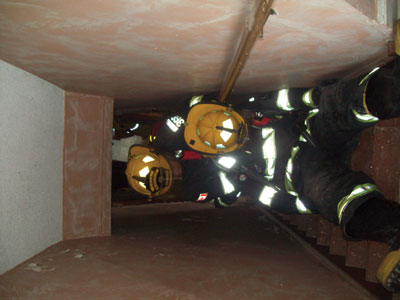 |
|
| Photo 1: It is easier to move a mayday firefighter down a set of stairs than up. |
|
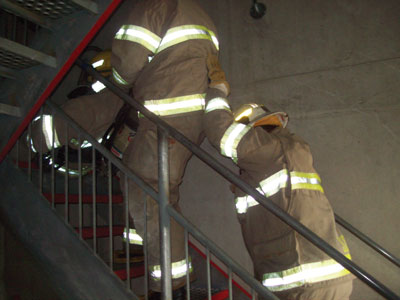 |
|
| Photo 2: When descending a flight of stairs, the second RIT firefighter positions himself behind the first RIT firefighter to act as a support and guide. | |
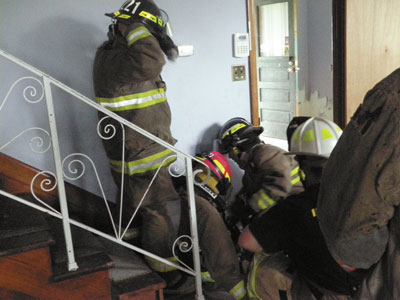 |
|
| Photo 3: When ascending a flight of stairs, RIT firefighters need to get the mayday firefighter’s back end as close as possible to the base of the first step. This requires sitting up the mayday firefighter and sliding him to that position. |
|
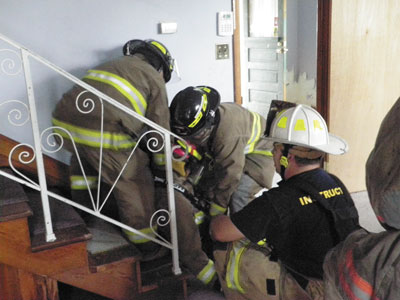 |
|
| Photo 4: Next, the RIT firefighters should lift the mayday firefighter up two or three steps at a time. This allows RIT members to position themselves for a proper lift the rest of the way up. |
|
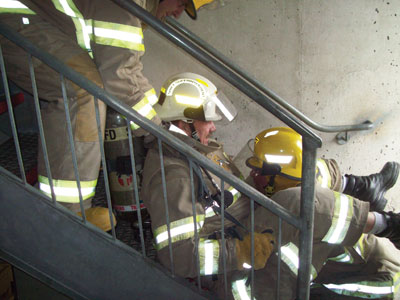 |
|
| Photo 5: Once the mayday firefighter is up two or three steps, the bottom RIT firefighter can reposition himself under the legs of the mayday firefighter. |
|
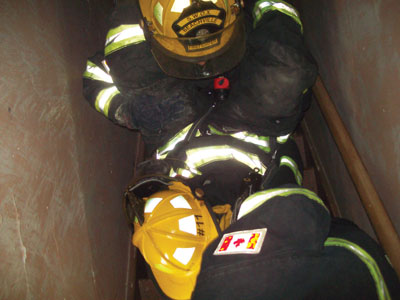 |
|
| Photo 6: There is less chance that the mayday firefighter’s legs will slide off if his thighs are resting on the RIT firefighter’s shoulders than if the knees are directly above the RIT firefighter’s shoulders. Photos by Mark van der Feyst Advertisement
|
Another area of concern is the handrail. The handrail cannot be relied upon to help support RIT members on the stairs. In an industrial or commercial building, the stairs are built to accommodate heavy and repeated use and the handrails are solid. But in a residential building, the handrails are not built to withstand repeated use or heavy weight. Grabbing the handrail to pull yourself up, or for support while carrying the mayday firefighter, can cause the rescue to fail. Do not rely on the handrail.
When rescuing a mayday firefighter, proper technique is crucial for success. Using brute force or muscle to lift or pull a mayday firefighter up or down stairs will not suffice; you will tire quickly. Weight-lifting skills work best with these evolutions as the proper techniques for a mayday rescue closely resemble deadlifts and squats. The top RIT firefighter performs a deadlift while the bottom RIT firefighter does a leg squat. Setting up in this fashion helps to ensure that the mayday firefighter gets up the stairs. Going up stairs is more difficult than going down stairs (see photo 1).
Gravity works to the advantage of RIT members when transporting a mayday firefighter down stairs. This task still requires two firefighters working in tandem to ensure the safe and effective removal of the mayday firefighter. One RIT firefighter drags the mayday firefighter to the edge of the top stair using proper drag techniques (the shoulder strap of the SCBA). When at the top stair, the RIT firefighter relocates one hand to grab the bottom of the SCBA cylinder around the bumper of the cylinder neck; this ensures full support and control of the mayday firefighter and also ensures that the cylinder neck will not catch on any part of the stair. This positioning also helps with pulling or dragging the mayday firefighter down the stairs as there are now two areas on which force is being applied to pull: the top area with the shoulder strap and the bottom area with the bottom of the SCBA cylinder.
The second RIT firefighter positions himself behind the first RIT firefighter to act as a support and guide while descending the stairs (see photo 2). This firefighter checks the steps as the RIT members go down, looking for any holes in the stairs and slowing down or braking the momentum of the down-the-stair removal. The second RIT firefighter should place his hands on the first firefighter’s back to help with this.
Going up a set of stairs is challenging: for this to work, the SCBA waist belt has to be converted into a harness. This conversion is done with the initial assessment and packaging of the mayday firefighter. The RIT members drag the mayday firefighter to the stairs. Once at the bottom of the stairs, RIT members will need to get the mayday firefighter’s back end as close as possible to the base of the first step. This requires sitting up the mayday firefighter and sliding him to that position (see photo 3).
The next step is to lift the mayday firefighter up two or three steps so that RIT members can position themselves for a proper lift the rest of the way up. This involves the top RIT firefighter pulling up or deadlifting the shoulder strap of the mayday firefighter’s SCBA, while the bottom RIT firefighter deadlifts the bottom half. This is accomplished by bear-hugging the mayday firefighter around the lower back and grabbing on to the waist belt of the SCBA. On a co-ordinated count, the mayday firefighter is lifted up two to three steps (see photo 4).
Once the mayday firefighter is up two or three steps, the bottom RIT firefighter repositions himself under the legs of the mayday firefighter. This requires the RIT firefighter to get down and dirty with the mayday firefighter. The shoulders of the RIT firefighter must be right in the middle of the thigh of the mayday firefighter (see photo 5). This positioning helps with the lift up the stairs and provides a more stable place for support. There is less chance that the mayday firefighter’s legs will slide off if his thighs are resting on the RIT firefighter’s shoulders than if the knees are directly above the RIT firefighter’s shoulders (see photo 6).
Once in position, RIT members can lift the mayday firefighter up the stairs in a co-ordinated fashion. Taking it one step at a time is best as it keeps the process consistent and prevents knocking over the top RIT firefighter.
Mark van der Feyst is a 14-year veteran of the fire service. He works for the City of Woodstock Fire Department in Ontario. Mark instructs in Canada, the United States and India and is a local-level suppression instructor for the Pennsylvania State Fire Academy and an instructor for the Justice Institute of B.C. E-mail Mark at Mark@FireStarTraining.com
Print this page